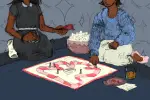It’s no secret that intentional conversation fosters intimacy. The process of getting to know someone beyond the surface provides valuable information regarding their morals and experiences. Humans innately desire to connect with others. However, asking the necessary questions to reach true understanding commonly comes off as awkward and misplaced.
When is the right time to ask someone about their deepest insecurities, fears and aspirations?
Accomplished psychotherapist Esther Perel offers a safe space to explore these themes through her new card game, “Where Should We Begin?”
Designed to elicit the storyteller in all of us, “Where Should We Begin?” presents each player with the opportunity to choose one of seven randomly-dealt prompt cards for another player to answer. These story cards range in topics – from life-changing decisions to self-image.
At each player’s consent, a fair share of material based on sexuality and physical intimacy holds space in the deck. However, players may opt out of these NSFW questions by simply removing the cards with a pink triangle at the bottom-right corner. After all, the goal of the game is to cultivate a safe space to understand one another. Whether a group incorporates pink cards or not, play is bound to result in surprise and realization.
SIMPLE
The “Simple” version of the game is recommended for first-time players or among new acquaintances. In this edition,players only use the 250 story cards and initiates a basic game of ask-and-answer.
Examples include: “The last time I felt lost…” and “I need to change…”
One of the game’s excellent qualities lies in its avoidance of narrow-mindedness.. Each card is generally up for individual interpretation, allowing for intrigue and revelations.
One story card reads, “My story of heartbreak.” The open-ended intro intends to be followed up with a tale of emotional grief. Upon the first read, many people would expect to hear a recounting of a sorrowful romantic breakup. Listeners may be stunned when they hear a tragedy that occurred between family members. In this way, players are primed to learn something unpredictable about their companions.
The game subverts expectations, a notably engaging characteristic.
ADVANCED
For more seasoned players or those up for a challenge, a second version of the game exists. The ”Advanced” rendition of the game integrates the 30 blue prompt cards and 12 game tokens.
Perel instructs players to “think of the prompt cards as the lens or the mood for the story” that the person who answers will tell. Picking from the prompt card deck, the storyteller receives the frame of mind from which they will answer the chosen question.
The tokens carry leverage in the storyteller’s choice of story card.
When playing with more than two people, the storyteller may take their pick of story cards from other players. However, players who wish for a certain question to be answered most have the option to place a token on that card. This makes the card a “loaded question” that the storyteller must respond to. In the instance that multiple players decide to use their tokens for different cards, the storyteller’s preference among the tokened options comes into play.
The incorporation of the prompt cards allows for specified creativity within the storyteller. While they may limit the potential stories the storyteller can narrate, this aspect of the game is more inventive than narrowing. The prompts help the storyteller to decide which story fits as the best response. They may even encourage the storyteller to recall a story they otherwise wouldn’t have considered.
Regardless, this version of the game requires a connection between the two cards that draws out creative thinking and personal insight.
As one prompt card reads, “Share something awkward.” Perhaps the story card selected questions, “A mistake I’ll never make again…”
In pondering on a response, the last few lines of Olivia Rodrigo’s “ballad of a homeschooled girl” comes to mind. In Rodrigo’s case, she could describe how she “thought your mom was your wife.” A mistake like this was probably something to learn from that indeed made the situation awkward for everyone involved.
Of course, the game has the potential to extract heavier stories as well, but humorous anecdotes emerge just as frequently.
The game evidently instigates critical thinking for all players. With options for one-on-one play, entertainment among friends and amusement in the company of colleagues, “Where Should We Begin?” invites players to share their experiences in a game where everyone is on the same team. Responses may be funny, juicy and/or somber.
Nevertheless, every player will leave with a more comprehensive understanding of the people in their lives.
Perhaps, even a secret or two.

















